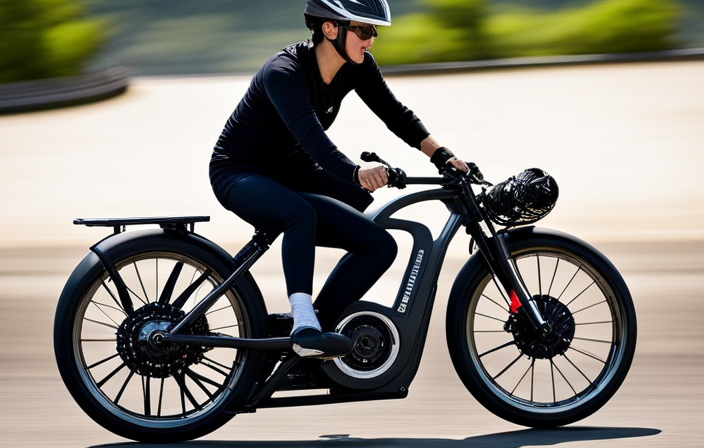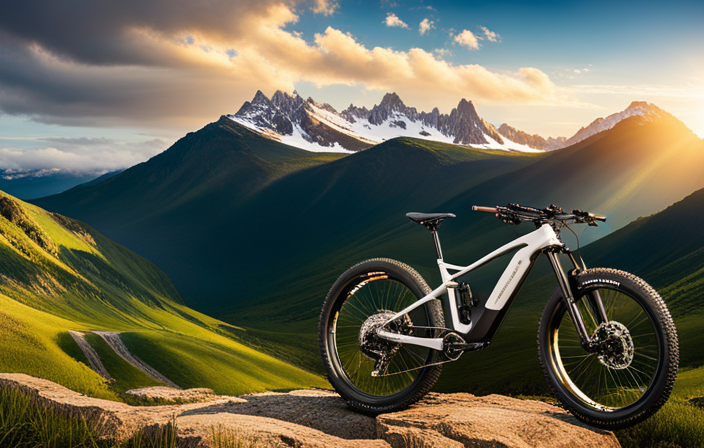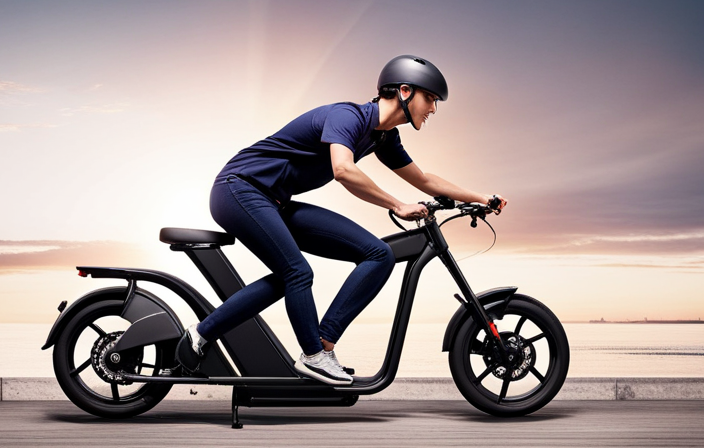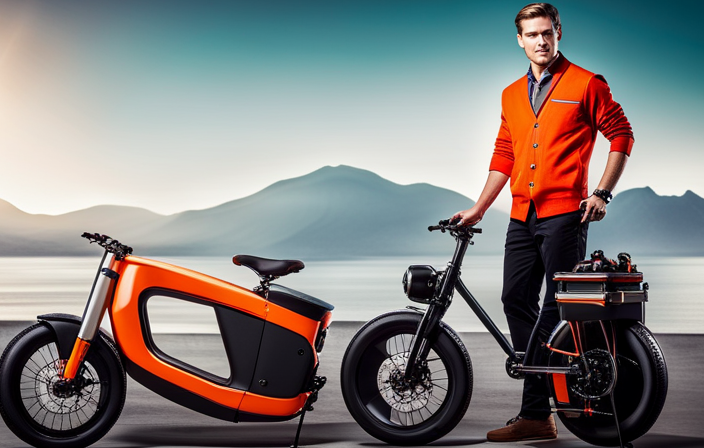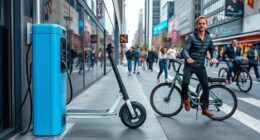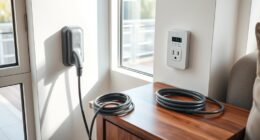Are you prepared to elevate your cycling journey to greater heights?
Picture yourself effortlessly gliding through city streets, feeling the wind rush past your face as you reach exhilarating speeds.
In this article, we will delve into the world of electric bikes and explore the maximum speed they can achieve.
From understanding the different classifications of electric bikes to uncovering the factors that influence their speed, we will equip you with the knowledge to make the most of your electric biking adventures.
So, tighten your helmet and get ready to discover the thrilling possibilities of electric bike speed.
Key Takeaways
- The maximum speed of an electric bike can be increased by upgrading the motor and battery for a speed boost.
- Improving aerodynamics through a streamlined design, fairings, or shields can enhance the e-bike’s speed.
- Proper tire inflation and maintenance play a crucial role in improving the e-bike’s performance and speed.
- The maximum speed of an electric bike may be limited by local regulations or the manufacturer’s specifications.
Understanding Electric Bikes
The maximum speed of an electric bike varies depending on the model and regulations in different countries. Electric bike technology has come a long way in recent years, providing numerous advantages over traditional bicycles.
With the assistance of an electric motor, riders can effortlessly conquer hills and cover long distances without breaking a sweat. Electric bikes also offer the option of pedal-assist, where the motor kicks in to amplify the rider’s pedaling power. This allows for a more efficient and enjoyable riding experience.
However, it is important to note that there are legal limits and regulations in place to ensure the safety of riders and pedestrians. These limits dictate the maximum speed an electric bike can reach, ensuring they are not classified as motor vehicles.
Legal Limits and Regulations
You should be aware of the legal limits and regulations regarding how fast you can ride an e-bike. Electric bike speed limits are determined by laws and regulations set by each country or state.
In the United States, for example, electric bikes are classified into three categories: Class 1, Class 2, and Class 3. Class 1 e-bikes have a maximum assisted speed of 20 mph, while Class 2 e-bikes have a maximum speed of 20 mph but can also be propelled without pedaling. Class 3 e-bikes have a maximum assisted speed of 28 mph. It is important to note that these limits may vary depending on the jurisdiction.
To ensure compliance, riders must also adhere to other legal requirements for electric bikes, such as age restrictions, helmet laws, and where they can ride. Understanding these legal limits and regulations is crucial to safely and legally ride an e-bike.
Moving on to factors affecting electric bike speed…
Factors Affecting Electric Bike Speed
To increase your e-bike’s speed, consider factors such as terrain, motor power, and battery capacity.
When it comes to terrain, a flat surface allows for higher speeds compared to hilly or rough terrains.
Additionally, the power of the motor plays a significant role in determining the maximum speed. A more powerful motor can propel the bike at higher speeds.
Moreover, the battery capacity affects the maximum speed as it determines how long the bike can sustain high speeds before needing a recharge.
Bike modifications, such as reducing weight or improving aerodynamics, can also contribute to increased speed.
Additionally, speed control systems can be installed to limit the maximum speed for safety purposes.
Transitioning to the subsequent section about classifying electric bikes, it is important to understand the different classifications that exist.
Classifying Electric Bikes
Classifying electric bikes involves understanding the different categories they fall into based on their features and capabilities. One common way to classify electric bikes is by their maximum speed. Electric bikes can be categorized into different speed categories, each with their own set of regulations and restrictions. Here is a table that outlines the classification methods and the corresponding speed categories:
| Classification Method | Speed Category |
|---|---|
| Class 1 | Up to 20 mph |
| Class 2 | Up to 20 mph |
| Class 3 | Up to 28 mph |
| Speed Pedelec | Up to 28 mph |
| Off-road | Varies |
Understanding the different speed categories is important when choosing an electric bike that suits your needs and complies with local regulations. Now, let’s delve into the next section and explore the concept of understanding speed pedelecs.
Understanding Speed Pedelecs
When understanding speed pedelecs, it’s important to know their capabilities and restrictions. Speed pedelecs are a type of electric bike that have a maximum assisted speed of 28 miles per hour (45 kilometers per hour). These bikes are equipped with advanced electric bike technology, including a powerful motor and a larger battery capacity.
However, it’s crucial to note that speed pedelecs are subject to specific regulations in different countries and regions. For example, in some places, riders may need a special license or registration to operate a speed pedelec. Additionally, there may be restrictions on where these bikes can be ridden, such as limiting access to certain bike paths or requiring riders to wear helmets.
Understanding these regulations is essential to ensure safe and legal use of speed pedelecs.
Moving on to the fastest electric bikes, let’s explore their thrilling capabilities.
The Fastest Electric Bikes
If you’re interested in high-speed electric bikes, you’ll be glad to know that there are several models available that can satisfy your need for speed. These bikes are designed for performance, with powerful motors and efficient battery systems that can propel you at impressive speeds.
In fact, there have been speed records set by riders on electric bikes, pushing the limits of what these machines are capable of. The future of high-speed electric bikes looks promising, with advancements in technology and design that will continue to push the boundaries of speed and performance.
High-Speed Electric Bike Models
To find the maximum speed of an electric bike, you can check out various high-speed electric bike models available in the market. These models often come with electric bike modifications that enhance their speed capabilities.
One way to determine the speed of an electric bike is through speed testing methods. Manufacturers use various techniques, such as GPS tracking or radar guns, to accurately measure the top speed of their bikes. Additionally, they may conduct wind tunnel tests to optimize the bike’s aerodynamics for higher speeds.
By examining these high-speed electric bike models and their speed testing methods, you can gain valuable insights into the maximum speeds that electric bikes can achieve. This knowledge can then be used to evaluate the performance and speed records of different electric bike models.
Performance and Speed Records
Now that you’ve learned about high-speed electric bike models, let’s dive into the exciting world of performance and speed records.
Electric bike speed records have been steadily increasing as technology continues to advance. Factors such as motor power, battery capacity, aerodynamics, and weight play a significant role in determining the maximum speed of an electric bike.
In recent years, electric bikes have reached impressive speeds of over 60 miles per hour (96 kilometers per hour), showcasing their immense potential. These speed records not only demonstrate the capabilities of electric bikes but also highlight the relentless pursuit of pushing the boundaries of what is possible.
As we explore the future of high-speed electric bikes, we will delve into the advancements in technology and design that will further revolutionize this exhilarating mode of transportation.
The Future of High-Speed Electric Bikes
The future of high-speed electric bikes looks promising as advancements in technology and design continue to revolutionize this exhilarating mode of transportation. Here are four future advancements that will have a significant impact on transportation:
-
Improved Battery Technology: Expect to see electric bikes with longer ranges and faster charging times, making them more convenient and practical for daily use.
-
Lightweight Materials: The use of advanced materials like carbon fiber and titanium will reduce the weight of electric bikes, enhancing their speed and maneuverability.
-
Enhanced Motor Power: Electric bikes will feature more powerful motors, allowing for higher top speeds and better acceleration.
-
Smart Connectivity: With the integration of smart technologies, electric bikes will offer features like GPS navigation, smartphone connectivity, and real-time performance monitoring.
These advancements will transform high-speed electric bikes into a reliable and efficient means of transportation. However, it is crucial to address safety considerations to ensure their widespread adoption.
Safety Considerations
Be aware of the safety considerations when using an electric bike, including the maximum speed. Safety measures are crucial to ensure a smooth and secure ride. One important safety consideration is the speed limitations of electric bikes. Different countries and regions have specific regulations regarding the maximum speed an electric bike can reach. These speed limitations are in place to promote rider safety and prevent accidents. It is essential to adhere to these regulations and understand the capabilities of your electric bike to avoid any potential risks. To provide a visual representation of these safety considerations, here is a table showcasing speed limitations in different regions:
| Region | Maximum Speed Limit |
|---|---|
| Europe | 25 km/h |
| United States | 32 km/h |
| Australia | 25 km/h |
| Canada | 32 km/h |
Knowing the speed limitations will help you ride your electric bike safely and responsibly. Now, let’s explore some tips for increasing electric bike speed.
Tips for Increasing Electric Bike Speed
If you’re looking to increase the speed of your electric bike, there are several key points to consider.
First, upgrading your motor and battery can provide a significant boost in speed. By investing in a more powerful motor and higher capacity battery, you’ll be able to achieve faster speeds and better acceleration.
Additionally, improving the aerodynamics of your bike can also make a notable difference in speed. By reducing wind resistance with streamlined design elements, you can maximize your bike’s efficiency and increase its top speed.
Lastly, don’t forget about proper tire inflation and maintenance. Ensuring that your tires are properly inflated and in good condition can help reduce rolling resistance and improve overall performance.
Upgrading Motor and Battery
When upgrading the motor and battery, you can increase the maximum speed of an electric bike. Upgrading the battery life is a crucial step in boosting speed. An upgraded battery will provide more power and allow the motor to run at higher speeds for longer periods. This means you can cover more distance in less time.
Additionally, improving motor efficiency will also contribute to increased speed. A more efficient motor will convert more electrical energy into mechanical energy, resulting in a faster bike. It’s important to choose a motor and battery that are compatible with each other for optimal performance.
Now, let’s move on to the next section about improving aerodynamics to further enhance your electric bike’s speed.
Improving Aerodynamics
To further enhance your e-bike’s speed, a key factor to consider is improving the aerodynamics. By incorporating a streamlined design and reducing wind resistance, you can significantly increase your bike’s maximum speed. One effective way to achieve this is by optimizing the bike’s body shape. A sleek, narrow frame with minimal protrusions can greatly reduce air drag, allowing you to cut through the wind effortlessly. Additionally, adding fairings or shields around the wheels and handlebars can further minimize turbulence and improve overall aerodynamics.
To give you a clearer visual representation, consider the following table:
| Component | Description | Benefit |
|---|---|---|
| Streamlined frame | Narrow and sleek design | Reduced air drag for improved speed |
| Fairings | Shields around wheels and handlebars | Minimized turbulence for better aerodynamics |
Improving the aerodynamics of your e-bike is an essential step towards achieving higher speeds. Now, let’s move on to the next section, where we will discuss the importance of proper tire inflation and maintenance.
Proper Tire Inflation and Maintenance
To ensure optimal performance of your e-bike, it is important to maintain proper tire inflation and perform regular maintenance tasks. Proper tire inflation is crucial for improved handling, control, and maneuverability of your electric bike, as well as reducing rolling resistance for better speed and efficiency. To maintain proper tire inflation, follow these steps:
- Check the tire pressure regularly using a pressure gauge.
- Inflate the tires to the recommended pressure level indicated on the sidewall of the tire.
- Inspect the tires for any signs of damage or wear, such as cuts or bulges.
Regular maintenance is equally important. Keep your tires clean and free from debris to avoid any performance issues caused by small particles. Additionally, ensure that the tires are properly aligned and balanced. By following these tire maintenance practices, you will enhance the overall performance and longevity of your e-bike.
Transitioning into the subsequent section, the benefits of electric bikes are not only related to speed but also to their eco-friendly nature and cost-effectiveness.
Benefits of Electric Bikes
You’ll love the benefits of electric bikes. Not only do they provide an efficient mode of transportation, but they also have a positive impact on the environment.
Electric bikes are designed to improve efficiency by utilizing a battery-powered motor to assist with pedaling. This means you can travel longer distances without getting tired, making them perfect for commuting or leisurely rides.
Additionally, electric bikes have a lower environmental impact compared to traditional vehicles. They produce zero emissions and require less energy to operate. By choosing an electric bike, you can contribute to reducing air pollution and minimizing your carbon footprint.
In conclusion, electric bikes offer a greener and more convenient way to get around, making them an excellent choice for both practical and eco-conscious individuals.
Conclusion and Final Thoughts
In summary, electric bikes are a convenient and eco-friendly transportation option that can enhance your daily commute or leisurely rides. With increasing power and efficiency improvements, electric bikes have become a popular choice among riders of all ages and fitness levels.
The maximum speed of an electric bike depends on various factors, including the motor power, battery capacity, and weight of the rider. On average, most electric bikes have a top speed of around 20 to 28 miles per hour (32 to 45 kilometers per hour). However, some high-performance electric bikes can reach speeds of up to 45 miles per hour (72 kilometers per hour) or more.
It’s important to note that the maximum speed may be limited by local regulations or the bike’s manufacturer. Overall, electric bikes offer a thrilling and efficient way to travel, while also reducing carbon emissions and promoting a healthier lifestyle.
Frequently Asked Questions
Are electric bikes allowed on all types of roads and bike paths?
Electric bikes are subject to different regulations depending on the jurisdiction. Some areas allow electric bikes on all types of roads and bike paths, while others may have restrictions. Electric bikes offer numerous benefits such as increased efficiency and reduced environmental impact.
Can the speed of an electric bike be adjusted according to the rider’s preference?
You have complete control over the electric bike’s speed, like a conductor leading an orchestra. With the ability to adjust the speed to your preference, you can effortlessly navigate any terrain or road.
What safety gear is recommended when riding an electric bike at high speeds?
When riding an electric bike at high speeds, it is crucial to wear recommended safety gear. This includes a helmet to protect your head from potential injuries, as well as protective clothing to safeguard your body.
How do electric bikes handle different types of terrain, such as hills or gravel roads?
Electric bikes handle different terrains with ease. The electric bike suspension ensures a smooth ride on hills and gravel roads. Plus, the battery life is optimized to provide maximum power and efficiency throughout your journey.
Are there any limitations on the weight or size of riders who can use an electric bike?
There are limitations on weight and size of riders when using an electric bike. Electric bikes have a maximum weight capacity that riders should not exceed to ensure optimal performance and safety.
Conclusion
So, now you know all about electric bikes and their maximum speeds. With the advancement of technology, electric bikes have become a popular choice for transportation and recreation. Although there are legal limits and regulations in place, you can still enjoy the thrill of riding at higher speeds by choosing the right class of electric bike.
While safety considerations should always be a top priority, you can increase your electric bike’s speed by following some simple tips. With the numerous benefits they offer, electric bikes are a fantastic option for anyone looking for an efficient and eco-friendly mode of transportation.
Don’t let any doubts hold you back from experiencing the exhilaration of riding an electric bike!
